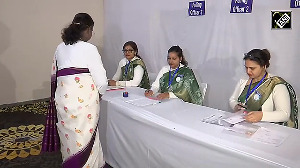Bharat Goenka, managing director of Tally whose accounting software has made it one of the most successful Indian product companies, appears crestfallen. Can we stop shooting ourselves in the foot? He is bemused by the recent Budget decision to levy an excise duty on packaged products sold off-the-shelf but waive it if the same software is downloaded.
"What does it do to all the investment we are making to set up a channel for the sale of our product?" he asks. Selling packaged branded software by the hundreds of thousands to the retail customer is the holy grail of the IT product business. "We have been making a huge effort for 16 years now to create an ecosystem for products and we will continue to do so as we believe in the business," Goenka asserts.
If Tally has met a temporary roadblock, others in the product business are facing far more fundamental, in fact, existential issues. Impulsesoft, the creator of a successful wireless Bluetooth IP has just been acquired. Does the acquisition indicate that it is really tough going for product companies out of India?
Seeds of success
K Srikrishna, president and CEO of Impulsesoft takes a longer-term view. "Infosys is a 25-year-old company; it takes time to build a product culture. It is relatively easy to come up with a promising idea, converting it into a business proposition that ultimately survives is another matter," he explains.
Critically, you need capital at every step in the evolution of the product and the company. And for capital to be meaningful it has to be of the right type. For such capital you will not go to a VC (venture capitalist), which will have its exit firmly indicted on its radar but an angel investor who understands the product business and is willing to stand by the company.
N S Raghavan, Infosys founder, was the seed investor for Impulsesoft. The firm made a small profit in 2003-04 and in 2004-05 a respectable net margin of about 10 per cent. Around 54 per of its revenue comes from product and NRE (non-recurring engineering expenses).
"We crossed the survival stage but then found that as the market evolved, customers and suppliers started squeezing us." The value chain in the space in which Impulsesoft operates begins with the IC (integrated circuit) vendors and ends with telecom service providers.
As the technology and market have matured, IC vendors have sought to deal directly with the OEM brands in a regime of falling prices. Since Impulsesoft and SiRF Technologies, which has taken it over, are in the same space, their joint capabilities can offer an integrated play from silicon to solution to keep the bigger boys at bay.
At every stage you need fresh funding and the choice always is to give up a part of the equity or the whole of it. Impulsesoft chose the latter path.
However, this is par for the course, in the opinion of Jay Pullur, founder of Pramati Technologies, a clear success in the software products space, which has won a Nasscom award. Product companies can create a lot of value because when they change hands the valuation can be in multiples of revenue.
In the case of a services company, the valuation is at most 1.5 or twice revenue. Also, once a product is successful, revenue growth becomes non-linear.
There can be degrees of this. In software products there is a window of opportunity. Pramati scored in terms of both a technology win and a market win. Its J2E1.3 technology server competed with global firms like IBM and BEA and replaced some of their products. "We also contributed to the evolution of standards. After six years we have broken even and will closed this year with half a million dollars in net profit," says Pullur.
There are several other clear winners in the Indian products space. One of them is Ittiam, which creates intellectual property in the digital signal processing space and has developed successful reference designs for an IP videophone and portable video player. "You can't enter a mature market, so it must be a new market. We have helped shape two - for the phone and the player," affirms Srini Rajam, chairman and CEO.
Build a brand
IT Technology can be divided into chip and end-equipment. "In end-equipment design, I can say with some confidence that maybe we are just there. Today, there is nothing more than packaging and plastics in design that we don't do," says Rajam. "What we need to do know is to build brands. Here you have to choose.
"If you want to sell a Walkman, you will have to compete with Sony. If you want to create a brand in a leading edge product, offer a $150 IP videophone that nobody is offering. There the newness of your brand is offset by the fact that it is not available otherwise," he explains.
In a sense, though, Tejas Networks, which produces next generation optical transmission equipment allowing voice and data combination, is already there in terms of design and brand building - albeit in the B2B space.
Says Sanjay Nayak, CEO, "From being a company with good products, we are becoming a large player in our space. Our revenue will triple in 2005-06 to Rs 135 crore (Rs 1.35 billion).
"Units shipped this quarter were equal to what was shipped in the entire last year. We are now one of top three in India among competitors like Siemens and Alcatel. We are proving our business model of partnering OEMs and showing how a company from India can go global."
Another Indian product company, which has been riding the global telecom services boom is Subex which produces revenue maximisation software for telecom service providers. Once its product has been accepted globally, it has embarked on an acquisition strategy.
Says Subash Menon, president and CEO, "Our acquisition strategy has paid off and as a result we have some large telcos among our customers and more are coming. The share of the Americas market in our turnover has risen from 10 to 47 per cent in the last 18 months. We have sort of acquired competing fraud management solutions. By 2009 when we hope to reach a topline of $ 100 million, we hope to have a global market share of 25 per cent from the current 10 per cent."
Interestingly, the only Indian software major, which is visibly present in the Indian product space is Infosys with its Finacle banking solutions suite. In the first three quarters of 2005-06, six of its 15 core banking solution wins came from among the global 500. The standardisation in banking practices, with the Basel II norms making banking practices global has clicked for Infosys.
"This will give a boost to replacement and reduce maintenance in a market in which 80 per cent of the spend is on maintenance," says Merwin Fernandes, business head of Finacle. At the end of the day, though, Finacle accounts for a bare three per cent of Infosys revenue and this is around half of that of flexcube, now owned by Oracle. So the going is good but there's a long way to go.
What's in a label, anyway?
Building software products is fine but what's the distinction between a software product and software product firm? Products typically have an identity, brand, distinctive packaging and earn a premium on the basis of their brand value. However, software need not be packaged for it to be able to command intellectual property (IP) rights.
Subash Menon of Subex sets the cat among the pigeons by declaring that only applications sold to end users can be called software products. IP firms are different and a firm that designs and develops its boxes and outsources their manufacturing is a hardware firm.
K Srikrishna of Impulsesoft disagrees. In his view, Cisco is a software company selling its software in boxes. All the value is generated from software and firmware. He, however, tends to go along with Menon that revenue per employee in a product firm is a multiple of what it is in a services firm. Jay Pullur of Pramati disagrees.
Having a revenue stream from IP is important but not a must. You can develop an open source software product, give it away free and run your business on services built around that product.
To him, a software product company is one whose product can be sold to many without much customisation. There is a key element of scale. However, then, what do you call proprietary ERP solutions that take a lot of customisation and ages to install?
Need to nurture
Says Goenka, "India has not been successful so far in growing software product companies because we think that services companies have to graduate to product companies to rise up the value chain. Even Nasscom is guilty of this kind of erroneous thinking. No product company started off as a services company. Product and services companies belong to different business verticals. The risk-reward ratio is higher in products."
So how do you get an ecosystem for nurturing product companies? This ecosystem has elements like mindset, investment for development and investment for marketing. In investment for development, fortunately you need far smaller initial teams to develop products and starting a company for this than for services.
A services company today has to be of minimum size. But costs change when you look at investment for marketing. Goenka says, "The cost of setting up a channel is the same for every business. To get this for software product companies you need a class of investors who see this as a business. For a market to be created, you have to believe in the market and make it happen. We have been doing this for 16 years. I have never believed that money can be a show stopper."
But even before you think of the ecosystem you have to know what kind of an animal a software product is in order to successfully develop it. Says Pullur, "Products emerge out of innovations. You can't make the same product differently and still get into the market. You have to look for a discontinuity. This can result from technology change, market change or customer habit change. iPod scores not on technology but on meeting a customer need."
To grow something you obviously need to incubate it. But the idea of an incubator has changed from what it was say when Pramati started off. The cost of a PC or telecommunication costs have plummeted.
Today, what is needed foremost is guidance and participation of a mentor in advising on what is needed to create a business. Also, you need seed funding of some size. Critically, Ittiam was able to garner adequate funding all along and Tejas has had the guidance of Desh Deshpande of Sycamore fame.
All successful Indian software product companies have ambitious plans. Ittiam has made significant design wins and sees 2006-07 as the year of volumes. Tejas, whose products have been accepted, will also get volumes through the OEM partnership route.
Subex will continue to look for acquisitions, expect significant wins and hope to gain market share. And Tally has lined up an innovative ERP package which if feels will revolutionise the use of ERP by Indian business.
The going is certainly tough but the tough have got going.
Points to ponder
-
No product company started off as a services company
-
Product and services companies belong to different business verticals
-
It takes time to build a product culture
-
You need the guidance and participation of a mentor
-
You can't enter a mature market, so it must be a new market
-
You have to believe in a market and make it happen
-
To grow something, you need to incubate it
-
You need capital at every stage in the product evolution
-
Wanted: Not a VC but an angel investor who's willing to stand by your company
- Once a product is successful, revenue growth becomes non-linear
Do you want to discuss stock tips? Do you know a hot one? Join the Stock Market Discussion Group







 © 2025
© 2025